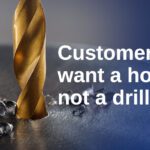Urko’s Forbes Interview #1: How to Validate a Market
We’ve been talking about market validation. So far we’ve argued why it’s really important and the value it can bring. But how do you do it? This week we spoke with Urko Wood an expert in growth strategy and innovation who helps companies determine where to focus and what to do to drive growth through innovation. Urko has a storied experience helping companies find opportunities that match their skill sets and needs. With software reducing the time necessary to get products in the hands of customers, it’s easy to think that the hard work and heavy lifting of market validation is no longer necessary. Urko argues it’s still a fundamental step in the process of innovating.
* * * * * * *
 Urko, how do you validate a market?
Urko, how do you validate a market?
It all depends on what you mean by “validate a market.” There are two different kinds of market validation. There’s validating the market demand and then there’s validating the solution. These are two very different things and, consequently, how we go about them should be different, too. I see a lot of large companies and startups fail to make this distinction all the time and, consequently, they fail with new products because they’re going about the market validation and innovation process all wrong.
Can you tell us more about these differences and how you would go about validating the market in each case?
It starts with a clear understanding that customer needs are separate and distinct from the solutions that people buy to address those needs. Theodore Levitt was famous for telling his students that “People don’t want to buy a quarter inch drill. They want a quarter inch hole!” And although many people have heard this quote, most people don’t appreciate its implications for virtually all of the value creation activities that companies do. Levitt made it clear that a customer’s need – making the ¼” hole – is different from the solution – the ¼” drill. The “need” is whatever the customer is trying to accomplish or experience and it is separate and distinct from the various solutions that people may use to address it. If we’re going to be successful at driving growth through innovation we need to first validate the market demand (customer need) and only after that has been completed should we attempt to develop a solution and then validate that, separately.
So you’re saying that customers can tell us what they want? Really?
One of the implications of Levitt’s insight is that, with the help of a skilled interviewer, customers can tell us what they want to accomplish and/or experience. The conventional wisdom that “customers have latent unarticulated needs, needs that they cannot articulate,” is simply wrong when we are talking about what people want to accomplish rather than about product specifications. Customers can tell us what they want to accomplish and/or experience, such as make a ¼” hole, cut the grass, clean the floor, etc. What they cannot often do, and we should not ask them to do, is come up with the next great solution. That’s not their responsibility; that’s the supplier’s responsibility. Just as a doctor is responsible for conducting a diagnosis on the patient before prescribing treatment and then creating the treatment plan, suppliers should take responsibility for conducting a diagnosis on their customers to understand what they’re trying to accomplish and where they’re struggling, and then develop the best solution based on their expertise in solutions.
But isn’t Henry Ford famous for retorting that, “If I had asked people what they wanted, they would have told me they wanted a faster horse?”
Yes, thank you for bringing that up – that is a great illustration of my point! You see, Ford asked the wrong question. The question isn’t “What do you want?” because that leads people to think in terms of solutions which, as I said, they generally are not qualified to do. Rather the question should be, “What do you want to get done with a horse?” People can answer that without any problem – they want to go from A to B, or transport goods from A to B – and the answer to this kind of question is usually very illuminating for anyone who wants to innovate.
It sounds like you might disagree with the Lean Startup approach of launching a minimum viable product in order to learn what customers want. Is that correct?
That’s correct. Generally, I think the lean startup approach encourages people to do the wrong thing better. It’s based on the same faulty assumption that I was just talking about, that we cannot discover customer’s needs before launching a product. This is absolutely false when we’re talking about what customers want to accomplish rather than product requirements. Eric Ries, the instigator of the Lean Startup movement, doesn’t make this distinction and he encourages companies to launch a minimum viable product (MVP), do as many product iterations as possible, in the shortest time possible, to learn as much as possible about what customers want. This might sound good until you realize that he’s trying to validate both the customer need and the solution all at the same time, which often leads to failing at both.
* * * * * * *
Now there’s a controversial thought in today’s innovation world. Urko explains more in the second half of his interview: When Not to “Fail Faster”.




